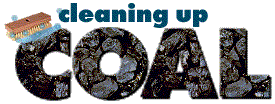John Galt Contaminates West Virginia Water Supply Because Industries Demand Freedom
Some of the more than 300,000 residents of West Virginia who could not drink or bathe in their tap water derived from the Elk River have been told that it is now safe to do so. Considering how flawed the process was for coming up with the standard for a safe level of the contaminant, 4-methylcyclohexane methanol (MCHM), it should come as no surprise that residents are not buying the claim that the water is now safe:
Eric Foster got the call last night. West Virginia American Water said the water at his South Charleston home is safe.
But that doesn’t mean he’s ready to use it again.
“The water smells like licorice, and I don’t really think that’s safe,” Foster said. “I’ll never drink it again.”
Five days after a chemical spill into the Elk River left water unusable for 300,000 West Virginia American Water customers in nine counties, some residents are still wary of using the water even after officials say it’s safe again.
Water company and state officials say the water consistently tested below 1 part per million of the chemical, and have been lifting the water-use ban zone by zone. Six zones, mostly in Charleston and South Charleston, had been lifted as of Tuesday evening.
Here’s a summary of the flawed process for coming to that one part per million “safe” standard:
Unfortunately, the science behind this standard remains unclear. Based on what we do know, there are good reasons to believe that officials are overlooking significant health risks.
We know, for example, that the manufacturer’s Material Safety Data Sheet (MSDS) that officials say they are using as their primary source lacks any information about chronic health impacts. The major federal databases we consulted suggest such data simply do not exist for this chemical.
It also appears that officials made significant leaps in their calculation of a “safe” exposure level – including assumptions that deviate from generally accepted practices. As a result, these estimates fail to adequately account for either acute or chronic health effects from ongoing exposure to water contaminated at the 1 ppm level.
At a bare minimum, the public deserves to know a lot more about the calculations behind officials’ insistence that a 1 ppm level in drinking water is safe.
But how did we get to this situation in the first place? The event that caused the ongoing contamination of the Elk River was a leak of thousands of gallons of MCHM from a facility owned by a company with the wonderfully Galtian name of Freedom Industries. Of course there is a bald eagle anchoring their website! Would you expect anything else?
How is the chemical used? It is used to perpetuate the myth of “clean coal”. Our government is even a leading crusader for this myth and boasts a nifty gif to show us how coal can be “cleaned”.
One of the main methods of producing “clean coal” is to remove particles of sulfur. From the DOE website with the nifty gif:
Take sulfur, for example. Sulfur is a yellowish substance that exists in tiny amounts in coal. In some coals found in Ohio, Pennsylvania, West Virginia and other eastern states, sulfur makes up from 3 to 10 percent of the weight of coal.
/snip/
One way is to clean the coal before it arrives at the power plant. One of the ways this is done is by simply crushing the coal into small chunks and washing it. Some of the sulfur that exists in tiny specks in coal (called “pyritic sulfur ” because it is combined with iron to form iron pyrite, otherwise known as “fool’s gold) can be washed out of the coal in this manner. Typically, in one washing process, the coal chunks are fed into a large water-filled tank. The coal floats to the surface while the sulfur impurities sink. There are facilities around the country called “coal preparation plants” that clean coal this way.
It appears that the MCHM is used sometimes instead of water in this process. But even after this “washing”, the coal is far from clean:
But coal has issues. Each lump can contain large amounts of sooty particulates, sulfur and nitrogen compounds (which cause acid rain), and traces of mercury and other toxic metals. Although coal-fired power plants are cleaner than they used to be, they are still bad news for the environment and human health. A recent study concluded that coal emissions contribute to 10,000 premature deaths in the United States each year. And coal is by far the largest single source of greenhouse gases in the U.S. So it is no surprise that coal has long been the primary target of proposals to cut air pollution and carbon-dioxide emissions.
In other words, the washing process falls far short of removing all of the toxic components of coal, and even if it did, the fact that the primary burning product of coal is carbon dioxide means that coal as an energy source is our largest producer of greenhouse gases. Perfectly clean coal would still be the primary route that we will destroy our environment through climate change.
So think about this for a moment. The myth of “clean coal” is destroying the planet through climate change. And in a charade of “cleaning” the coal, a company that apparently is subject to almost no regulatory oversight has contaminated the water for over 300,000 people.
Cincinnati is closing its water inlets on the Ohio River today as the contamination plume moves through that area. But House Speaker John Boehner, who “represents” Ohio, still favors his Galtian attitude of deregulation. Because industries demand freedom, obviously. Even when that freedom contaminates water and ruins the climate.



Nestle` has already announced plans to dominate the potable water market of the future and the wealthy will pay whatever so this is not a problem. Where is Ohio and W. Virginia, I know we fly over them on our way to Vail/Aspen or L.A., anyway until my water is poinsoned let’s continue with deregulation and austerity for the takers.
Mom works, so she doesn’t breastfeed. The media (in a variety of ways) has made it clear to mom that breastpumps are evil, plus her boss won’t let her take breaks to go pump, anyway, so the baby is fed formula. Mom and dad can’t afford bottled water, so the formula is made with tap. Baby loses a few more IQ points and follows dad into mining, rather than go to college and discover an alternative to coal.
I’m sorry. Did I miss some downside?
In the same vein, notice that the privately owned water company, American Water Works’ subsidiary West Virginia Water, didn’t notice that the water had turned blue and smelled like licorice. The monitors are the citizens, sort of like tasters at a Borgia Banquet.
This, in an area called chemical valley.
I would have used hexane as the starting point, and I suspect that it isn’t all that safe. Benzene, with the same ring structure, is definitely unsafe.
Haven’t any of the safety guys had general chemistry?
@P J Evans: I think hexane with an alcohol substituent is the closer analogue. The ring is saturated, so it’s very different from benzene with its double bonds.
@P J Evans: Please, everyone knows chemistry has a liberal bias.
@Jim White:
True, but I didn’t feel like pulling the CRC Handbook off the shelf to look, not right then. I bet it has cyclohexane, though. (I have Brady’s Materials, but it’s in a box in the storage unit.)
Thanks for reporting this. If some Muslim extremist rogue double agents had polluted the water supply of a major city, the EPA might do something. But the fossil fuel industry can pollute air, earth and water without any penalties.
And think about the terrible things the NSA fear mongers warn us about terrorists. The rogue double agents might use Undie bombs to blow up airliners, or cyber malware against Microsoft operating systems, or attacks against Wall Street Hedge Fund gamblers. Chemical pollution is never a weapon used by Al Qaeda and its affiliates. The Al Qaeda affiliate in Fukushima would never be blamed for causing four nuclear plants to melt down.
The fossil fuel industry, Coal, and also nuclear power plants, can poison us, as much as they want. Maybe the One Percent is experimenting with small scale genocide, because they can.
Is there any living thing left in the river?
@mark: According to the Freedom Co. Pres fish are not harmed. It could be worse, remember when that river in Ohio caught on fire? To paraphrase Erin Burnett “You better not complain about poison water or you won’t get any water.”
@bsbafflesbrains:
thankyou.
@bsbafflesbrains:
And the guy who complained about his well water catching fire, brought a gallon to court and lit it to support his complaint, and had the fracking (adjective and verb) company trying to silence him on the grounds that it was some kind of defamation.
the chemical is not super nasty but it is a poorly water-soluble skin irritant – imagine diesel fuel, or jet kerosene, that got into water supply in massive quantity. The water treatment plant upstream may have declared “all clear” but the greasy stuff now is clinging to all the plastic pipes in the water system and it will take weeks before it is gone, and the cold weather is not helping because the solubility decreases with the temperature/
I should add that froth flotation is hardly a clean technology in common sense of the term. It is a wet industrial enrichment process for upgrading low-quality coal, that would be otherwise uneconomical to mine/problematic to burn. It uses up lots of water, produces tailing sludge, a lot of it actually – chemical-contaminated sludge that has to be kept in ponds for long time. It is not an operation you would want to see running full scale in populated areas…
One little correction to the above: the inlet to the drinking-water plant is downstream from the spill-site.
Kind of reminds me of how we have things set up in Iowa City. The waste-water plant is on the Iowa River, just a bit upstream from the city, itself. The drinking-water inlet in a bit downstream from the city. This is supposedly OK, unless one has a flood. Then the waste-water plant is overwhelmed and starts dumping raw sewage, especially when the “ponds” are underwater. Unfortunately, we now have “100-year” floods every five years or so.
They have the same set-up in Cedar Rapids. During the Great Flood of 2008, people reported seeing rather unsavory objects drifting along on the flooded downtown streets. Only Mike Myers (in his role of Fat Bastard) would be proud of such “floaters.”
My chest always puffs up when I hear POTUS Barack Obama use “clean coal” in his speeches!